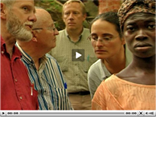

Ideas for Congregations
Buy the DVD. Purchase the DVD and gather a group at your church or home to watch the film together. Before you begin, look through the list of resources below.
Organize a screening and dialogue in your congregation.
Use the DVD to discuss and share the experience of your community. The Unitarian Universalist association created a guide to accompany the film. You can find it here or download POV’s secular discussion guide for small groups here. You can also check out the additional resources for dialogue on this site and the POV website.
Preach it. Consider preaching on the issues the film raises, either before or after hosting a screening. What can we learn from Scripture? How are we called to respond as a faith community? Read the complete text of Katrina Browne’s sermon at St. Michael’s Episcopal Church in Bristol, and send us your sermons to post for others to read (email us at info@tracesofthetrade.org).
Partnerships. While you may watch the film alone or in your own group, it is helpful to search out partners from other communities to share the experience, widening the circle of concern and potential action. Watch the film, then invite others to join you. The challenge is always to ask the question: who is not at the table? A broader group allows for a deeper and richer conversation about our history, which can lead to greater compassion and understanding. Consider the youth and different generations of your own community, and other congregations from different ethnic or racial groups than your own.
Research the history of your faith community in slavery and its aftermath. Uncovering the details of your faith tradition’s role in slavery is a crucial part of the process of repair and reconciliation. While many people of faith took a stand against slavery, Christian institutions and individuals in the U.S.—North and South—were central to its perpetuation. Areas to explore:
• Christian justifications of and support for slavery and racism (both Protestant and Catholic) that began in Europe and were carried over into the American colonies.
• Direct participation: Ministers—North and South—often owned slaves, and there are examples of church bodies, such as missionary societies, owning plantations, the profits from which funded their work.
• To the extent that the “people in the pews” participated in and profited from a slave-based economic system, what is the history of clergy support or opposition? Might your congregation have been supported economically by wealth derived from slavery?
• Most Protestant denominations split over slavery at the time of the Civil War. How has your denominational history been shaped by this defining moment and what are the legacies and the lessons?
• In the years since federal abolition of slavery, what role has your congregation or your larger church body played in perpetuating or ending racism? How have they intersected with key chapters in the national story of racial discrimination and civil rights?
• If you belong to a non-Christian faith tradition, what at are the intersections between your religious body and the history of slavery and racism?
Theology, Liturgy, Ritual. Faith traditions teach us about acknowledgement of a breach, about mourning, apology, repentance and atonement, and forgiveness. They teach us about compassion, love and reconciliation. They establish moral and ethical values for justice and right relationships. And they teach us about the importance of prayer and ritual in healing. How might your faith community delve into the spirituality of repair, and create appropriate liturgies or rituals? How can music and the arts contribute?
Repair: Reflection & Action. Viewing and discussing Traces of the Trade leads us to many questions. What is the legacy of slavery—in your congregation, community, city, region, and in the nation? How are the issues raised in the film – racism and an economy based on oppression – at work in the current day? What steps can we take right now to begin the process of repair that can lead to reconciliation, remembering that reconciliation is not the beginning but the end product of this process of reflection, compassion, vision, and sacrifice?
The POV discussion guide supports a process of discernment about action steps. You can also visit our “Get Involved” page for concrete suggestions. For more information specifically on reparations, you can read this primer.
Next Steps: Advocacy & Legislative Action
Visit our advocacy resource page to get involved in campaigns fighting current-day slavery and human trafficking and connect with legislative efforts that apologize for slavery in your state. Learn more about campaigns working against the economic disparities between communities of color and white communities, including disparities in health, education, housing, and many other areas.
